Solah Shringar EXPOSED: The Untold Story Behind India’s Most Sacred Beauty Ritual!
Tarun Badghaiya | Feb 07, 2025, 18:14 IST
( Image credit : Timeslife )
For ages, Indian brides have practiced the Solah Shringar, a captivating 16-step beauty ritual that goes beyond conventional decoration. Each ingredient, from sindoor to payal, has a deeper spiritual and cultural connotation that dates back to ancient Vedic traditions. Did you realise that these traditions have scientific benefits? This essay delves into the hidden history, symbolism, and unexpected present relevance of these age-old beauty secrets. Whether you're a bride-to-be or a fan of Indian customs, prepare to be astounded by the power of these sacred adornments!
The Solah Shringar (16 Adornments) is an important part of Indian culture, steeped in tradition, mythology, and spirituality. It refers to the sixteen most important decorations that enhance a woman's appearance, especially on momentous events such as weddings and religious celebrations. Solah Shringar tradition has grown over the ages and is a vital part of Indian history, as evidenced by old scriptures, sculptures, and paintings.
This tradition represents not only physical decoration but also a woman's spiritual well-being, prosperity, and marital happiness. Each ornament and cosmetic item has a rich cultural value and is frequently related to many aspects of nature, Hindu philosophy, and divine feminine energy.
Solah Shringar originated in Vedic periods and is mentioned in holy books such as the Rigveda, Atharvaveda, and Upanishads. In ancient literature, beauty and ornamentation were associated not just with appearance but also with divine grace, energy, and auspiciousness.
Solah Shringar was often represented in sculptures and temple carvings during the Gupta period (4th–6th centuries CE). The statues of goddesses such as Parvati, Lakshmi, and Saraswati frequently have lavish jewellery and adornments, reflecting the ideal beauty standards of the time.
In the mediaeval period, Rajput and Mughal queens popularised Solah Shringar by combining elements such as beautiful mehendi decorations, luxurious perfumes, and lavish clothing. The Mughal influence brought new jewellery types, including costly jewels, pearls, and enamel work (Meenakari).
During the British colonial era, Western fashion began to influence Indian dress trends, although indigenous adornments remained important, especially during religious and wedding festivities. Today, Solah Shringar is an important part of Indian bridal culture, representing both beauty and tradition.
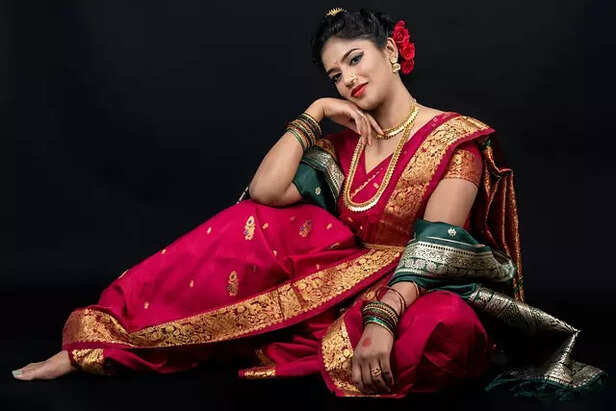
The bindi is a little ornamental dot placed on the forehead between the brows. In Hindu tradition, this location is known as the Ajna Chakra (third eye chakra), which is associated with knowledge and spiritual understanding. Historically, married women wore red bindis, which represented prosperity and marital status, while unmarried women wore black or other coloured bindis.
Sindoor is a crimson or orange powder that married ladies use to their hair partings (maang). It denotes marital joy, the husband's long life, and fertility. The tradition stretches back to ancient India, as evidenced by statues from the Harappan civilisation (c. 2500 BCE). Hindu deities, particularly Parvati, are often shown wearing sindoor, emphasising its religious significance.
A maang tikka is a decorative item worn at the hair parting and lying on the forehead. It represents the uniting of a bride and husband, which aligns with the Ajna Chakra's spiritual meaning. Historically, royal women in India wore it, especially at weddings and festivals.
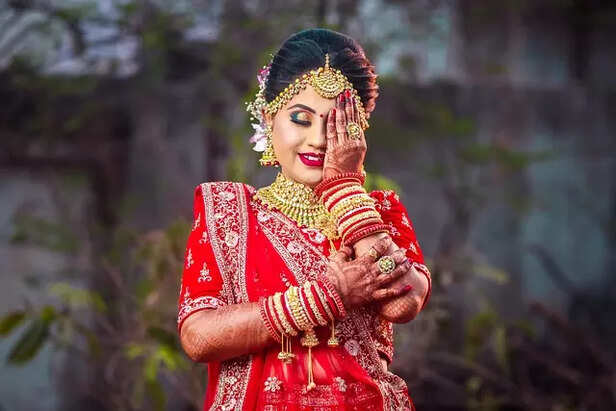
Applying kajal (kohl) brightens the eyes and protects against the evil eye (drishti). Historically, kohl was manufactured from soot and medicinal herbs, which were thought to have cooling and antibiotic effects. Kohl was utilised for cosmetic and spiritual purposes by both ancient Egyptian and Indian women.
The nath (nose ring) is a significant representation of marriage and femininity. In Ayurveda, the left nostril is associated with the female reproductive system, and piercing it is thought to reduce birthing discomfort. During the Mughal period, nose rings became popular, with ornate designs that included gold, pearls, and valuable stones.
Earrings, also known as Karn Phool (ear blossoms), represent riches and social standing. Women in ancient India wore large gold and silver earrings, which often extended to ear chains attached to their hair. Earrings were traditionally associated with spiritual well-being because the earlobes contain acupressure sites.
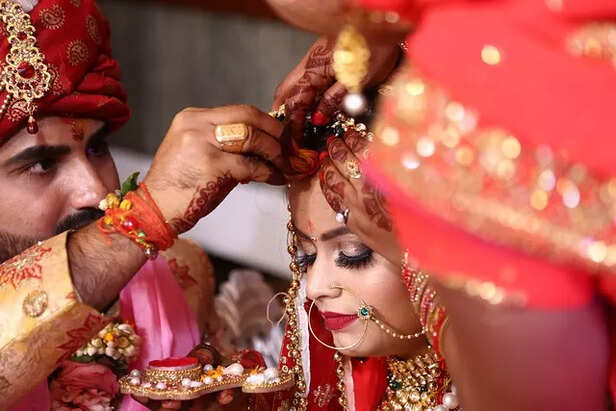
A bride wears numerous necklaces, including a mangalsutra, which the groom ties during the wedding ceremony to symbolise their holy link. Throughout history, several regions of India had diverse necklace styles, ranging from temple jewellery in South India to Kundan work in North India.
Mehendi (henna) is used to create beautiful designs on the hands and feet before weddings. It is regarded as auspicious, bringing luck, love, and success. Mehendi has cooling effects and was utilised in ancient Egypt, Persia, and India for medical and decorative purposes.
Bangles are an important part of a married woman's wardrobe. Red and green bangles indicate fertility and prosperity, while gold bangles represent wealth. The practice of wearing bangles dates back to the Indus Valley Civilisation, when archaeologists uncovered terracotta bangles from 2600 BCE.
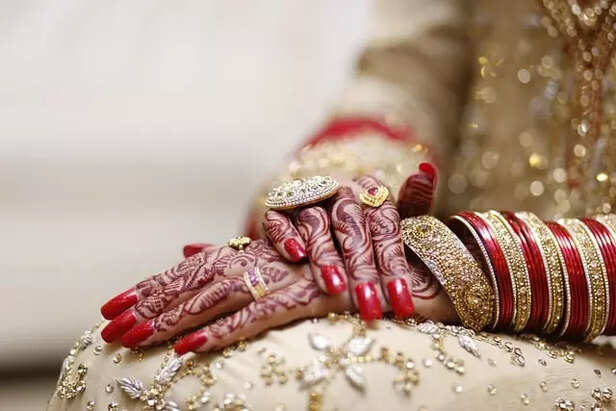
Worn on the upper arms, the bajubandh (armlet) represents strength and beauty. During the Gupta dynasty, queens and noblewomen wore armlets with exquisite gold and jewel decorations.
Rings highlight the beauty of a woman's hands. Some rings have unique designs, like the Aarsi ring, which features a little mirror that women use to catch a glimpse of their spouses.
The kamarbandh (waistband) highlights the waist and is seen as a symbol of elegance and fertility. During the Mughal Empire, it was a popular adornment for royal women, often adorned with pearls and diamonds.
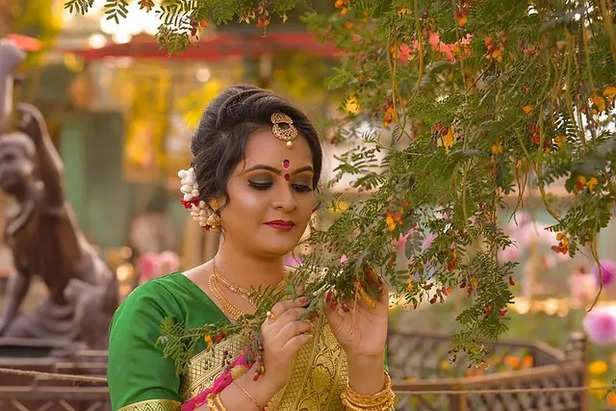
Payal (anklets) are typically made of silver and have a melodic sound. Gold is regarded as sacred in Hindu religion; hence, it is not worn on the foot. Anklets represent grace and feminine appeal.
Married Hindu ladies wear bichuas (toe rings) to symbolise their marital status. In Ayurveda, toe rings are thought to regulate menstrual cycles and improve fertility.
Using ittar (natural perfume) is an age-old tradition. Attar, made from flower and herbal extracts, was popular among Mughal queens and is still used in Ayurvedic medicine and aromatherapy today.
The Solah Shringar is completed with a saree or lehenga, which is typically red or maroon. The veil (ghoonghat) represents modesty and devotion. The affinity for red can be traced back to ancient Hindu scriptures, which associate the colour with Goddess Durga and marital prosperity.
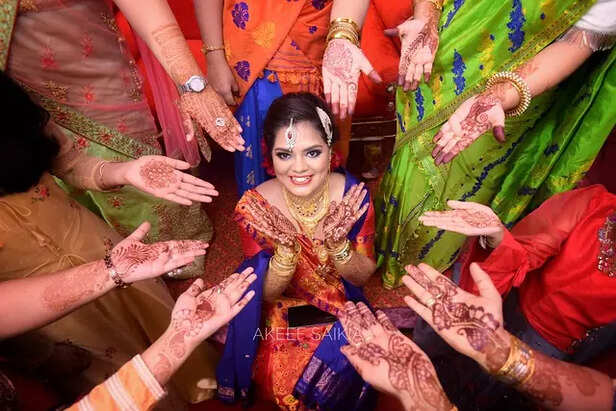
The Solah Shringar tradition is firmly ingrained in Indian culture, history, and spirituality. Each decoration is more than a decorative feature; it represents beauty, protection, prosperity, and divine grace. While modern fashion trends have influenced bridal styles, Solah Shringar remains an important aspect of Indian weddings and religious ceremonies, retaining the rich legacy and timeless grace of Indian femininity.
This tradition represents not only physical decoration but also a woman's spiritual well-being, prosperity, and marital happiness. Each ornament and cosmetic item has a rich cultural value and is frequently related to many aspects of nature, Hindu philosophy, and divine feminine energy.
Historical context and evolution
Solah Shringar was often represented in sculptures and temple carvings during the Gupta period (4th–6th centuries CE). The statues of goddesses such as Parvati, Lakshmi, and Saraswati frequently have lavish jewellery and adornments, reflecting the ideal beauty standards of the time.
In the mediaeval period, Rajput and Mughal queens popularised Solah Shringar by combining elements such as beautiful mehendi decorations, luxurious perfumes, and lavish clothing. The Mughal influence brought new jewellery types, including costly jewels, pearls, and enamel work (Meenakari).
During the British colonial era, Western fashion began to influence Indian dress trends, although indigenous adornments remained important, especially during religious and wedding festivities. Today, Solah Shringar is an important part of Indian bridal culture, representing both beauty and tradition.

Beautiful bride
( Image credit : Timeslife )
Sixteen Adornments of Solah Shringar
1. Bindi (forehead decoration).
The bindi is a little ornamental dot placed on the forehead between the brows. In Hindu tradition, this location is known as the Ajna Chakra (third eye chakra), which is associated with knowledge and spiritual understanding. Historically, married women wore red bindis, which represented prosperity and marital status, while unmarried women wore black or other coloured bindis.
2. Sindoor (vermillion powder)
Sindoor is a crimson or orange powder that married ladies use to their hair partings (maang). It denotes marital joy, the husband's long life, and fertility. The tradition stretches back to ancient India, as evidenced by statues from the Harappan civilisation (c. 2500 BCE). Hindu deities, particularly Parvati, are often shown wearing sindoor, emphasising its religious significance.
3. Maang Tikka (Hair ornament)
A maang tikka is a decorative item worn at the hair parting and lying on the forehead. It represents the uniting of a bride and husband, which aligns with the Ajna Chakra's spiritual meaning. Historically, royal women in India wore it, especially at weddings and festivals.

bride
( Image credit : Timeslife )
4. Kajal (kohl for eyes)
Applying kajal (kohl) brightens the eyes and protects against the evil eye (drishti). Historically, kohl was manufactured from soot and medicinal herbs, which were thought to have cooling and antibiotic effects. Kohl was utilised for cosmetic and spiritual purposes by both ancient Egyptian and Indian women.
5. Nath (nose ring)
The nath (nose ring) is a significant representation of marriage and femininity. In Ayurveda, the left nostril is associated with the female reproductive system, and piercing it is thought to reduce birthing discomfort. During the Mughal period, nose rings became popular, with ornate designs that included gold, pearls, and valuable stones.
6. Earrings (Karn Phool).
Earrings, also known as Karn Phool (ear blossoms), represent riches and social standing. Women in ancient India wore large gold and silver earrings, which often extended to ear chains attached to their hair. Earrings were traditionally associated with spiritual well-being because the earlobes contain acupressure sites.

indian marriage
( Image credit : Timeslife )
7. Necklaces (Haar, Mangalsutra)
A bride wears numerous necklaces, including a mangalsutra, which the groom ties during the wedding ceremony to symbolise their holy link. Throughout history, several regions of India had diverse necklace styles, ranging from temple jewellery in South India to Kundan work in North India.
8. Mehendi (Henna for Hands and Feet)
Mehendi (henna) is used to create beautiful designs on the hands and feet before weddings. It is regarded as auspicious, bringing luck, love, and success. Mehendi has cooling effects and was utilised in ancient Egypt, Persia, and India for medical and decorative purposes.
9. Bangles (Chooda / Kangan)
Bangles are an important part of a married woman's wardrobe. Red and green bangles indicate fertility and prosperity, while gold bangles represent wealth. The practice of wearing bangles dates back to the Indus Valley Civilisation, when archaeologists uncovered terracotta bangles from 2600 BCE.

Indian bride
( Image credit : Timeslife )
10. Armlets (Baju Bandh)
Worn on the upper arms, the bajubandh (armlet) represents strength and beauty. During the Gupta dynasty, queens and noblewomen wore armlets with exquisite gold and jewel decorations.
11. Ring (Anguthi)
Rings highlight the beauty of a woman's hands. Some rings have unique designs, like the Aarsi ring, which features a little mirror that women use to catch a glimpse of their spouses.
12. Waistband (kamarbandh)
The kamarbandh (waistband) highlights the waist and is seen as a symbol of elegance and fertility. During the Mughal Empire, it was a popular adornment for royal women, often adorned with pearls and diamonds.

Indian Bride
( Image credit : Timeslife )
13. Anklets (Payal)
Payal (anklets) are typically made of silver and have a melodic sound. Gold is regarded as sacred in Hindu religion; hence, it is not worn on the foot. Anklets represent grace and feminine appeal.
14. Toe rings (bichua)
Married Hindu ladies wear bichuas (toe rings) to symbolise their marital status. In Ayurveda, toe rings are thought to regulate menstrual cycles and improve fertility.
15. Perfume (ittar)
Using ittar (natural perfume) is an age-old tradition. Attar, made from flower and herbal extracts, was popular among Mughal queens and is still used in Ayurvedic medicine and aromatherapy today.
16. Bridal attire (saree or lehenga with veil).
The Solah Shringar is completed with a saree or lehenga, which is typically red or maroon. The veil (ghoonghat) represents modesty and devotion. The affinity for red can be traced back to ancient Hindu scriptures, which associate the colour with Goddess Durga and marital prosperity.

woman
( Image credit : Timeslife )
The Solah Shringar tradition is firmly ingrained in Indian culture, history, and spirituality. Each decoration is more than a decorative feature; it represents beauty, protection, prosperity, and divine grace. While modern fashion trends have influenced bridal styles, Solah Shringar remains an important aspect of Indian weddings and religious ceremonies, retaining the rich legacy and timeless grace of Indian femininity.
